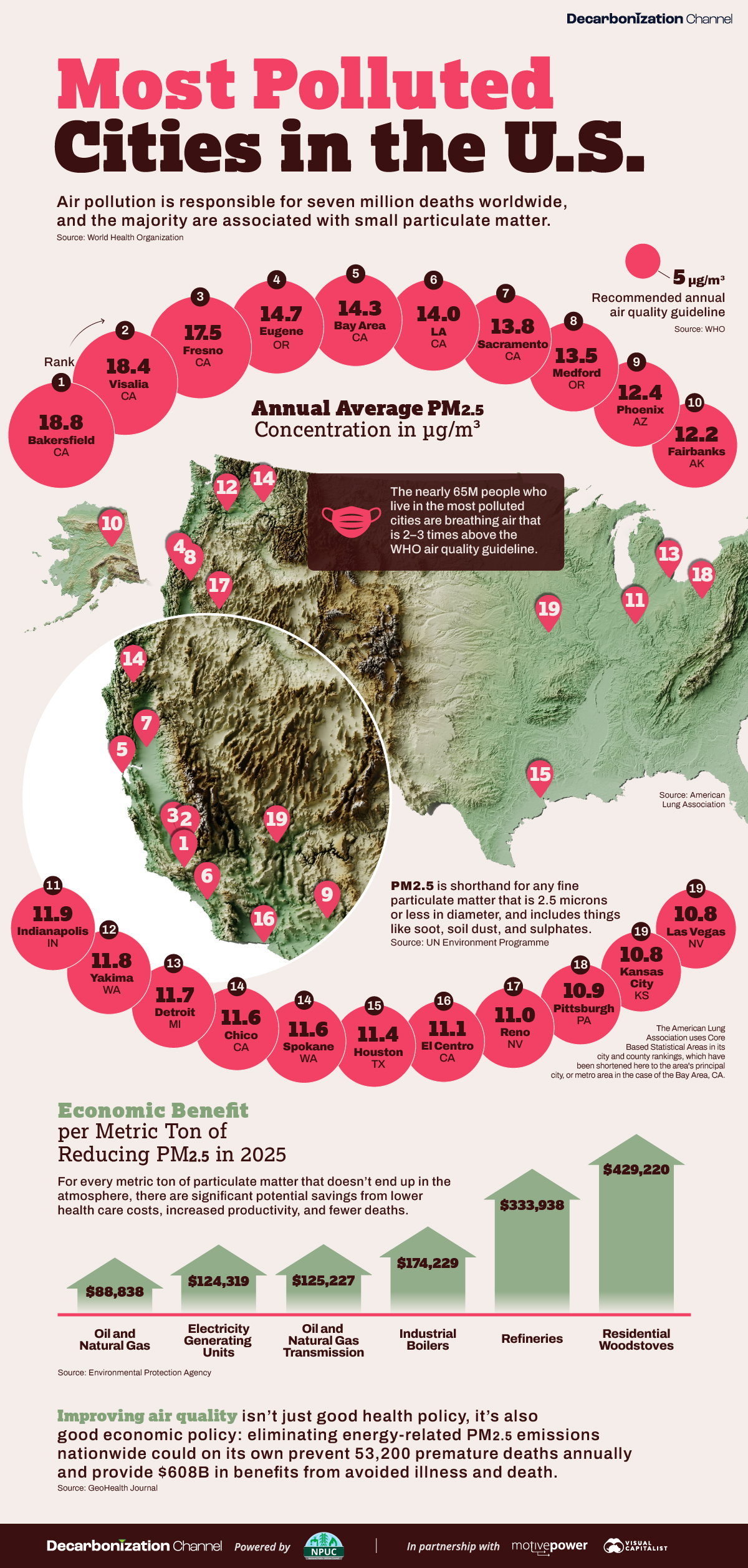Green
Visualized: Global CO2 Emissions Through Time (1950–2022)
Subscribe to the Decarbonization Channel’s free mailing list for more like this
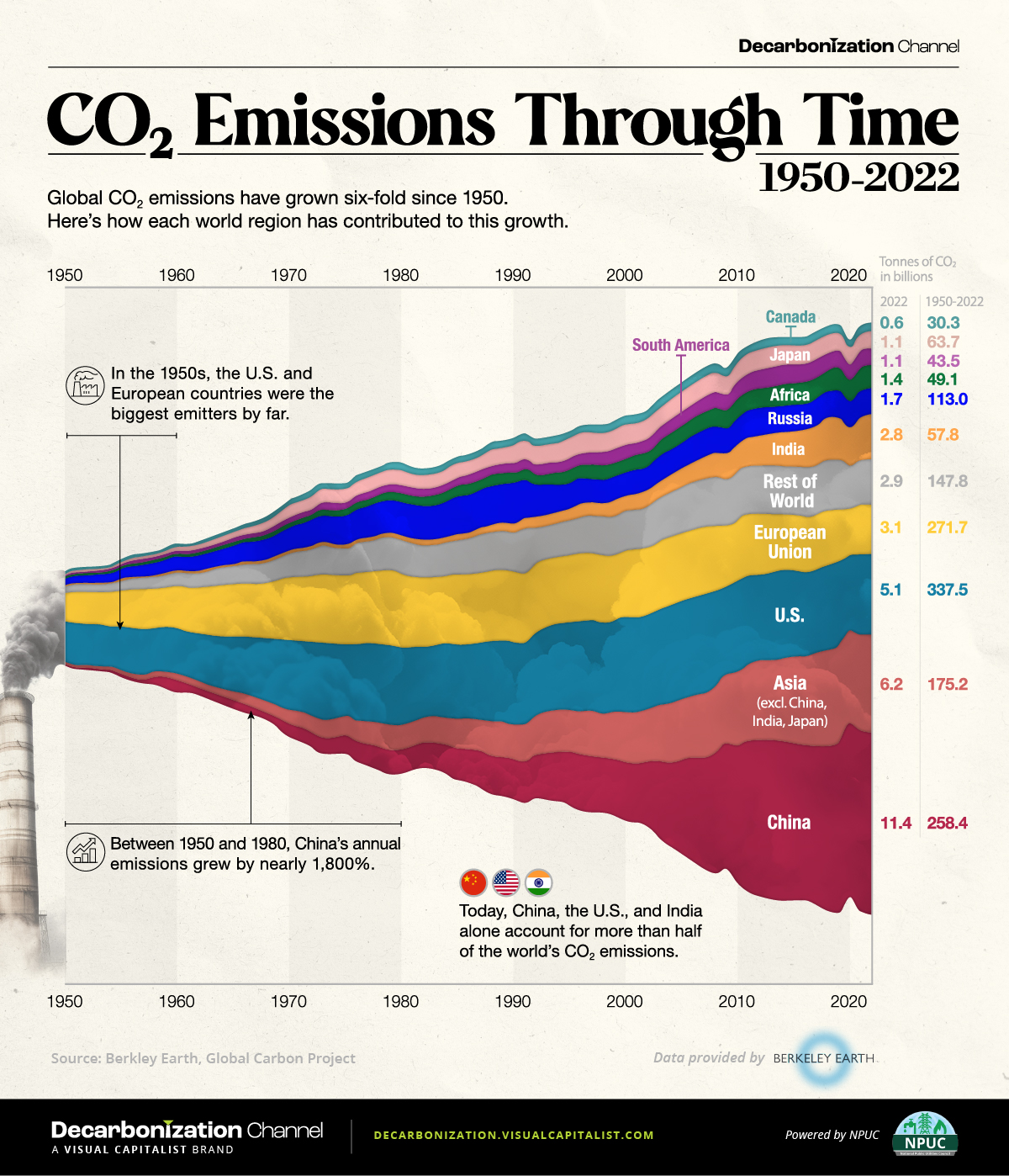
Visualized: Global CO2 Emissions Through Time (1950-2022)
This was originally posted on the Decarbonization Channel. Subscribe to the free mailing list to be the first to see graphics related to decarbonization with a focus on the U.S. energy sector.
Global CO2 emissions have grown six-fold since 1950.
But which countries have contributed the most to this growth?
In this streamgraph, created in partnership with the National Public Utilities Council, we answer that question using regional emissions data from Berkeley Earth and Global Carbon Project.
Global CO2 Emissions: The Last 70 Years in Review
In the 1950s, the United States and the countries that later formed the European Union (EU) were the biggest emitters in the world, responsible for over 70% of total annual emissions.
However, this trend swiftly changed as other nations entered the fray.
For instance, China’s economic surge in the 1970s, particularly with the advent of Deng Xiaoping’s new economic strategy in 1978, triggered a notable uptick in the country’s CO2 output. From 1950 to 2000, China witnessed a surge of over 4,500% in emissions, reaching an annual 3.6 billion tonnes by 2000.
Similarly, India, Japan, and the broader Asian region all experienced emission growth exceeding 1,000% between 1950 and 2000.
| Metric tons of carbon dioxide (tCO2) | 1950 | 2000 | 2022 | Change 1950–2000 | Change 2000–2022 |
|---|---|---|---|---|---|
| China | 0.1B | 3.6B | 11.4B | 4,529% | 213% |
| Asia (excl. China, Japan, and India) | 0.2B | 3.2B | 6.2B | 1,973% | 95% |
| United States of America | 2.5B | 6.0B | 5.1B | 136% | -16% |
| European Union | 1.8B | 4.2B | 3.1B | 134% | -26% |
| Rest of World | 0.4B | 2.5B | 2.9B | 465% | 16% |
| India | 0.1B | 1.0B | 2.8B | 1,500% | 189% |
| Russia | 0.4B | 1.5B | 1.7B | 256% | 12% |
| Africa | 0.1B | 0.9B | 1.4B | 876% | 52% |
| Japan | 0.1B | 1.3B | 1.1B | 1,132% | -17% |
| South America | 0.1B | 0.8B | 1.1B | 621% | 34% |
| Canada | 0.2B | 0.6B | 0.6B | 268% | -3% |
Data note: 1950 was used as a beginning point for the graph due to the lack of available data for many countries prior to that year.
As illustrated in the table above, the growth in global carbon emissions has slowed since 2000.
With that said, global emissions have still risen from 25 billion tonnes in 2000 to 37 billion in 2022, which is another all-time high. Today, over 40% of emissions come from the U.S. and China, underscoring their pivotal roles in shaping the global emissions landscape.
Where Are We Headed From Here?
The United Nations’ recent Emissions Gap report highlights a concerning reality: the ongoing rate of emissions combined with existing policies steers humanity towards a world that is 3°C warmer than pre-industrial levels. This contrasts starkly with the goals of 1.5–2°C agreed to in 2015.
The Intergovernmental Panel on Climate Change projects that such a degree of warming will potentially result in catastrophic repercussions, from severe changes in weather patterns to rising sea levels, widespread extinctions, and critical disruptions to global food and water systems.
Environment
The Most Polluted Cities in the U.S.
What are the most polluted cities in the U.S. according to data from the American Lung Association’s 2024 State of the Air Report?
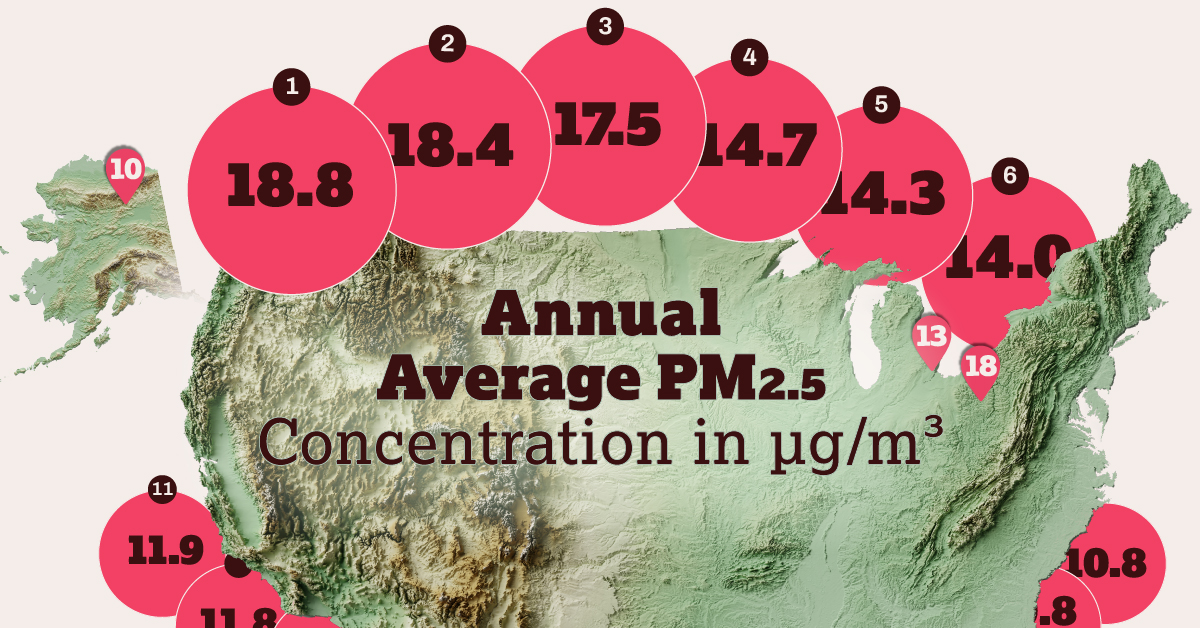
The Most Polluted U.S. Cities in 2024
According to the World Health Organization, air pollution is responsible for 7 million deaths annually, and could cost the global economy between $18–25 trillion by 2060 in annual welfare costs, or roughly 4–6% of world GDP.
And with predictions that 7 in 10 people will make their homes in urban centers by mid-century, cities are fast becoming one of the frontlines in the global effort to clear the air.
In this visualization, we use 2024 data from the State of the Air report from the American Lung Association to show the most polluted cities in the United States.
What is Air Pollution?
Air pollution is a complex mixture of gases, particles, and liquid droplets and can have a variety of sources, including wildfires and cookstoves in rural areas, and road dust and diesel exhaust in cities.
There are a few kinds of air pollution that are especially bad for human health, including ozone and carbon monoxide, but here we’re concerned with fine particulate matter that is smaller than 2.5 microns, or PM2.5 for short.
The reason for the focus is because at that small size, particulate matter can penetrate the bloodstream and cause all manner of havoc, including cardiovascular disease, lung cancer, and chronic pulmonary disease.
The American Lung Association has set an annual average guideline of 9 µg/m³ for PM2.5, however, the World Health Organization has set a much more stringent limit of 5 µg/m³.
The 21 Worst Polluted Cities in the U.S.
Here are the top 21 most polluted cities in the U.S., according to their annual average PM2.5 concentrations:
| Rank | City, State | Annual average concentration, 2020-2022 (µg/m3) |
|---|---|---|
| 1 | Bakersfield, CA | 18.8 |
| 2 | Visalia, CA | 18.4 |
| 3 | Fresno, CA | 17.5 |
| 4 | Eugene, OR | 14.7 |
| 5 | Bay Area, CA | 14.3 |
| 6 | Los Angeles, CA | 14.0 |
| 7 | Sacramento, CA | 13.8 |
| 8 | Medford, OR | 13.5 |
| 9 | Phoenix, AZ | 12.4 |
| 10 | Fairbanks, AK | 12.2 |
| 11 | Indianapolis, IN | 11.9 |
| 12 | Yakima, WA | 11.8 |
| 13 | Detroit, MI | 11.7 |
| T14 | Chico, CA | 11.6 |
| T14 | Spokane, WA | 11.6 |
| 15 | Houston, TX | 11.4 |
| 16 | El Centro, CA | 11.1 |
| 17 | Reno, NV | 11.0 |
| 18 | Pittsburgh, PA | 10.9 |
| T19 | Kansas City, KS | 10.8 |
| T19 | Las Vegas, NV | 10.8 |
Note: The American Lung Association uses Core Based Statistical Areas in its city and county rankings, which have been shortened here to the area’s principal city, or metro area in the case of the Bay Area, CA.
Six of the top seven cities are in California, and four in the state’s Central Valley, a 450-mile flat valley that runs parallel to the Pacific coast, and bordered by the Coast and Sierra Nevada mountain ranges. As a result, when pollution from the big population centers on the coast is carried inland by the wind—cities #5 and #6 on the list—it tends to get trapped in the valley.
Bakersfield (#1), Visalia (#2), and Fresno (#3) are located at the drier and hotter southern end of the valley, which is worse for air quality. The top three local sources of PM2.5 emissions in 2023 were farms (20%), forest management / agricultural waste burning (20%), and road dust (14%).
Benefit to Economy
While the health impacts are generally well understood, less well known are the economic impacts.
Low air quality negatively affects worker productivity, increases absenteeism, and adds both direct and indirect health care costs. But the flip side of that equation is that improving air quality has measurable impacts to the wider economy. The EPA published a study that calculated the economic benefits of each metric ton of particulate matter that didn’t end up in the atmosphere, broken down by sector.
| Sector | Benefits per metric ton |
|---|---|
| Residential Woodstoves | $429,220 |
| Refineries | $333,938 |
| Industrial Boilers | $174,229 |
| Oil and Natural Gas Transmission | $125,227 |
| Electricity Generating Units | $124,319 |
| Oil and Natural Gas | $88,838 |
At the same time, the EPA recently updated a cost-benefit analysis of the Clean Air Act, the main piece of federal legislation governing air quality, and found that between 1990 and 2020 it cost the economy roughly $65 billion, but also provided $2 trillion in benefits.
Benefit to Business
But that’s at the macroeconomic level, so what about for individual businesses?
For one, employees like to breathe clean air and will choose to work somewhere else, given a choice. A 2022 Deloitte case study revealed that nearly 70% of highly-skilled workers said air quality was a significant factor in choosing which city to live and work in.
At the same time, air quality can impact employer-sponsored health care premiums, by reducing the overall health of the risk pool. And since insurance premiums averaged $7,590 per year in 2022 for a single employee, and rose to $21,931 for a family, that can add up fast.
Consumers are also putting their purchase decisions through a green lens, while ESG, triple-bottom-line, and impact investing are putting the environment front and center for many investors.
And if the carrot isn’t enough for some businesses, there is the stick. The EPA recently gave vehicle engine manufacturer Cummins nearly two billion reasons to help improve air quality, in a settlement the agency is calling “the largest civil penalty in the history of the Clean Air Act and the second largest environmental penalty ever.”

Learn how the National Public Utilities Council is working toward the future of sustainable electricity.

-

 Environment1 month ago
Environment1 month agoRanked: Top Countries by Total Forest Loss Since 2001
The country with the most forest loss since 2001 lost as much forest cover as the next four countries combined.
-

 Environment3 months ago
Environment3 months agoCharted: Share of World Forests by Country
We visualize which countries have the biggest share of world forests by area—and while country size plays a factor, so too, does the environment.
-
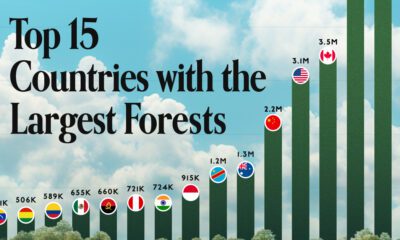
 Environment4 months ago
Environment4 months agoWhich Countries Have the Largest Forests?
Together, the top five countries with the largest forests account for more than half of the world’s entire forest cover.
-

 Environment5 months ago
Environment5 months agoVisualized: What Lives in Your Gut Microbiome?
The human gut microbiome contains a world of microbes. We look at the the bacteria that deeply affect our health and well-being.
-

 Green5 months ago
Green5 months agoMapped: Global Temperature Rise by Country (2022-2100P)
In this set of three maps, we show the global temperature rise on a national level for 2022, 2050, and 2100 based on an analysis by…
-
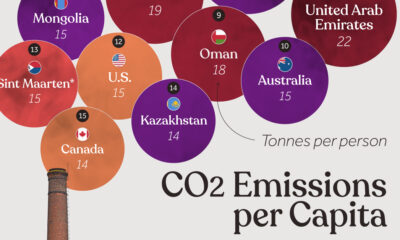
 Environment5 months ago
Environment5 months agoRanked: Per Capita Carbon Emissions by Country
Which countries rank the highest in per capita carbon emissions, and how do they impact the world’s total carbon emissions?
-

 Personal Finance1 week ago
Personal Finance1 week agoVisualizing the Tax Burden of Every U.S. State
-

 Misc6 days ago
Misc6 days agoVisualized: Aircraft Carriers by Country
-

 Culture6 days ago
Culture6 days agoHow Popular Snack Brand Logos Have Changed
-

 Mining1 week ago
Mining1 week agoVisualizing Copper Production by Country in 2023
-

 Politics1 week ago
Politics1 week agoCharted: How Americans Feel About Federal Government Agencies
-

 Healthcare1 week ago
Healthcare1 week agoWhich Countries Have the Highest Infant Mortality Rates?
-

 Demographics1 week ago
Demographics1 week agoMapped: U.S. Immigrants by Region
-

 Economy1 week ago
Economy1 week agoMapped: Southeast Asia’s GDP Per Capita, by Country











